Hardware and Software Solutions for the Generation of a Database of HSV-Color Characteristics for the Main Ores and Rocks of the Khibiny Massif
Abstract
1. Introduction
- (1)
- High emission intensity (when contacting with an ultraviolet light source with a maximum wavelength of 365 nm) of sodalite in a broad band that includes yellow, orange, and red areas of the visible light range, which thus precludes from identifying apatite there;
- (2)
- An application area that requires using the shortest analytical times (for exposure and registration);
- (3)
- The available emission color differences in the studied monomineral fractions, including the pink-violet color of apatite emission, the blue-green one of nepheline, the pink-red one of calcite, and the orange-yellow one of sodalite.
2. Materials and Methods
2.1. Material
- -
- ANO with a taxitic, banded structure and a holocrystalline, inequigranular, and panidiomorphic-granular texture with elements of a poikilitic one;
- -
- ANO with a taxitic, spotty structure and a holocrystalline, inequigranular, and panidiomorphic-granular texture with elements of a poikilitic one;
- -
- Urtite–ijolite with a taxitic structure and a holocrystalline, inequigranular, hypidiomorphic-granular, and agpaitic texture (Figure 1).
2.2. Methods and Equipment
2.2.1. Systematization of Petrographic and Mineralogical Parameters of Ores and Rocks
2.2.2. Hardware Solution for Studying HSV-Color Value of Main Ores and Rocks from the Khibiny Massif and Composing Minerals
2.2.3. Analysis of HSV-Color Value of Minerals Occurring on the Surface of the Studied Samples
3. Results
3.1. Cross-Platform Application: “Core Material Analysis”
- -
- To control the measurement process (by moving the core material through the analysis zone, camera calibration, and image recording);
- -
- To create and systematize the description of the textural and structural features in the studied sample;
- -
- To process core surface images (by identifying structural units by their HSV-color characteristics, visualizing the results and reference markups, and demonstrating statistical information about the mineral to the user).
3.2. Results of the Analysis of HSV-Color Value in Minerals Occurring on the Surface of the Studied Samples
3.2.1. Visible Light Range
3.2.2. Ultraviolet Light Range
4. Discussion
- -
- The amount of images in the training set to be increased;
- -
- The quality of analysis for each image to be improved;
- -
- Any errors to be identified and a comparative assessment executed of color characteristics for the HMCA distinguished in various core regions.
5. Conclusions
- -
- The systematization of primary information about the core sample used (affiliation to the type of ore and/or rock, textural and structural characteristics of the constituent minerals, the form of apatite, etc.), which allows taking into account the variability of the color palette of apatite depending on its ore affiliation and granularity;
- -
- The generation of a training set based on expert markups of the core surface images (in the visible light range) relied upon the assessment of such physical properties of minerals as coloration, luster, cleavage, and hardness;
- -
- The analysis of two optical characteristics of the mineral, including the color of the mineral and color of its luminescence excited by an ultraviolet light source with a maximum wavelength of 365 nm.
Author Contributions
Funding
Data Availability Statement
Acknowledgments
Conflicts of Interest
References
- Shibaeva, D.N.; Kompanchenko, A.A.; Bulatov, V.V.; Asanovich, D.A. Express Assessment of Apatite Content in Apatite-nepheline Ores of Ultrabasic Alkaline Complexes Based on its Luminescent Properties (the first study stage). Minerals 2023, 13, 37. [Google Scholar] [CrossRef]
- Gorobets, B.S.; Rogozhin, A.A. Luminescence Spectra of Minerals. Guidebook; VIMS: Moscow, Russia, 2001; p. 316. ISBN 5-901837-01-0. [Google Scholar]
- Tereshchenko, S.V. Scientific Bases of Luminescent Separation of Mineral Raw Materials. Ph.D. Thesis, Saint Petersburg Northwestern State Technical University, Saint-Petersburg, Russia, 4 October 2005. [Google Scholar]
- Rassulov, V.A. Luminescent Spectrometry of Zircon, Fluorite, Scheelite and Apatite as an Indicator of the Ore-Formational Type of Deposits. Ph.D. Thesis, Russian State Geological Prospecting University, Moscow, Russia, 22 December 2011. [Google Scholar]
- Votyakov, S.L.; Borisov, D.R.; Kholodnov, V.V.; Chashchukhina, V.A.; Krasnobaev, A.A. Luminescence as a basis for typification of apatites from various rocks and ores of the Urals. Yearbook 1995, 1996, 74–78. [Google Scholar]
- Yan, Q.; Liu, Z.; Guo, Y. Study on Fluorescence Properties of Green-Blue Apatite. Crystals 2022, 12, 866. [Google Scholar] [CrossRef]
- Prozorova, G.V. Analysis of rock void space from digital core photographs using computer vision algorithms. Bulletin of the Russian New University. Ser. Complex Syst. Models Anal. Manag. 2021, 4, 48–57. [Google Scholar] [CrossRef]
- Petrographic Code of Russia. Magmatic, Metamorphic, Metasomatic, and Impact Formations, 3rd ed.; Sharpenok, L., II, Ed.; Corrected and Supplemented; VSEGEI Publishing House: St. Petersburg, Russia, 2009; p. 200. [Google Scholar]
- Neradovsky, Y.N.; Kompanchenko, A.A.; Chernyavsky, A.V. Texture and Mineral Composition of Magmatic Apatite-Nepheline Ores: Technological Consequences (Exemplified by Khibiny). In Proceedings of the IOP Conference Series: Earth and Environmental Science, Online, 10–12 January 2022; p. 032031. [Google Scholar] [CrossRef]
- Nesteruk, S.; Agafonova, J.; Pavlov, I.; Gerasimov, M.; Latyshev, N.; Dimitrov, D.; Kuznetsov, A.; Kadurin, A.; Plechov, P. MineralImage5k: A benchmark for zero-shot raw mineral visual recognition and description. Comput. Geosci. 2023, 78, 105414. [Google Scholar] [CrossRef]
- Plechov, P.Y.; Trousov, S.V.; Bychkov, K.A.; Konovalova, K.A. Multilayered mineralogical information in spectroscopy of minerals. In Proceedings of the XIX International Meetingon Crystal Chemistry, X-ray Diffraction and Spectroscopy of Minerals, Apatity, Russia, 2–8 July 2019; p. 43. [Google Scholar]
- Volotov, E.M.; Nesterov, S.V.; Mitrofanov, I.V.; Akimenko, T.A.; Efimov, A.N.; Kokorina, S.B. Method of elimination of the distortions of the image brought at the expense of the video camera lens distortion. Izv. Tula State Univ. Tech. Sci. 2018, 12, 283–291. [Google Scholar]
- Zhirov, D.V. New interpretation of the Khibiny foidolite complex tectonics and resourse potential of phospates. Proc. Fersman Sci. Sess. GI KSC RAS 2020, 17, 184–189. [Google Scholar] [CrossRef]
- Tudić, V.; Kralj, D.; Hoster, J.; Tropčić, T. Design and Implementation of a Ball-Plate Control System and Python Script for Educational Purposes in STEM Technologies. Sensors 2022, 22, 1875. [Google Scholar] [CrossRef] [PubMed]
- Ershov, E.I.; Korchagin, S.A.; Kokhan, V.V.; Bezmaternykh, P.V. A generalization of Otsu method for linear separation of two unbalanced classes in document image binarization. Comput. Opt. 2021, 45, 66–75. [Google Scholar] [CrossRef]
- Tabbone, S.; Wendling, L. Multi-scale binarization of images. Pattern Recognit. Lett. 2003, 24, 403–411. [Google Scholar] [CrossRef]
- Shaikh, S.H.; Maiti, A.K.; Chaki, N. A new image binarization method using iterative partitioning. Mach. Vis. Appl. 2013, 24, 337–350. [Google Scholar] [CrossRef]
- Ma, X.; Zhang, P.; Man, X.; Ou, L. A New Belt Ore Image Segmentation Method Based on the Convolutional Neural Network and the Image-Processing Technology. Minerals 2020, 10, 1115. [Google Scholar] [CrossRef]
- Open, C.V. Changing Color Spaces. Available online: https://docs.opencv.org/4.x/df/d9d/tutorial_py_colorspaces.html (accessed on 9 October 2022).
- Kostyleva-Labuntsova, E.E.; Borutsky, B.E.; Sokolova, M.N.; Shlyukova, Z.V.; Dorfman, M.D.; Dudkin, O.B.; Kozyreva, L.V. Mineralogy of the Khibiny Massif (Minerals); Nauka Pubish: Moscow, Russia, 1978. [Google Scholar]
- Marfinin, A.S.; Mineeva, R.M.; Mkrtchyan, A.R. Optical and Mössbauer spectroscopy of iron in rock-forming silicates. Izv. AS USSR Ser. Geol. 1967, 10, 86–102. [Google Scholar] [CrossRef]
- Dudkin, O.B. About the nature of characteristic coloring of some minerals in alkaline rocks and pegmatites. Mater. Mineral. Kola Peninsula 1967, 5, 169–184. [Google Scholar]
- Bulanova, Z.F. Testing of the Kukisvumchorr apatite deposit by ore types. Notes Leningr. Order Lenin Labor Red Banner Min. Inst. Named G.V. Plekhanov 1959, XXXVI, 84–94. [Google Scholar]
- Geiger, L.; Team, P. Larq: An Open-Source Library for Training Binarized Neural Networks. J. Open Source Softw. 2020, 5, 1746. [Google Scholar] [CrossRef]
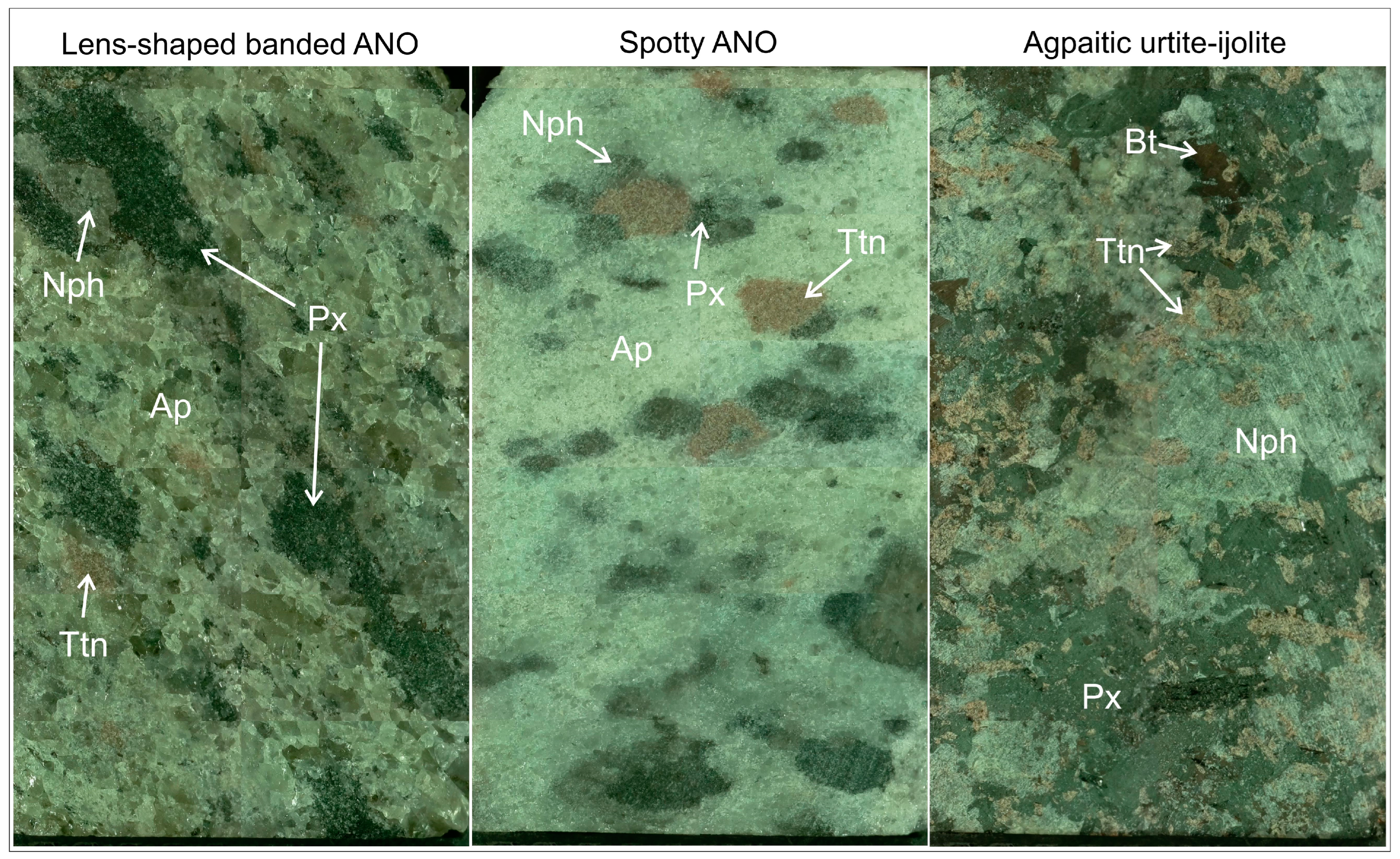

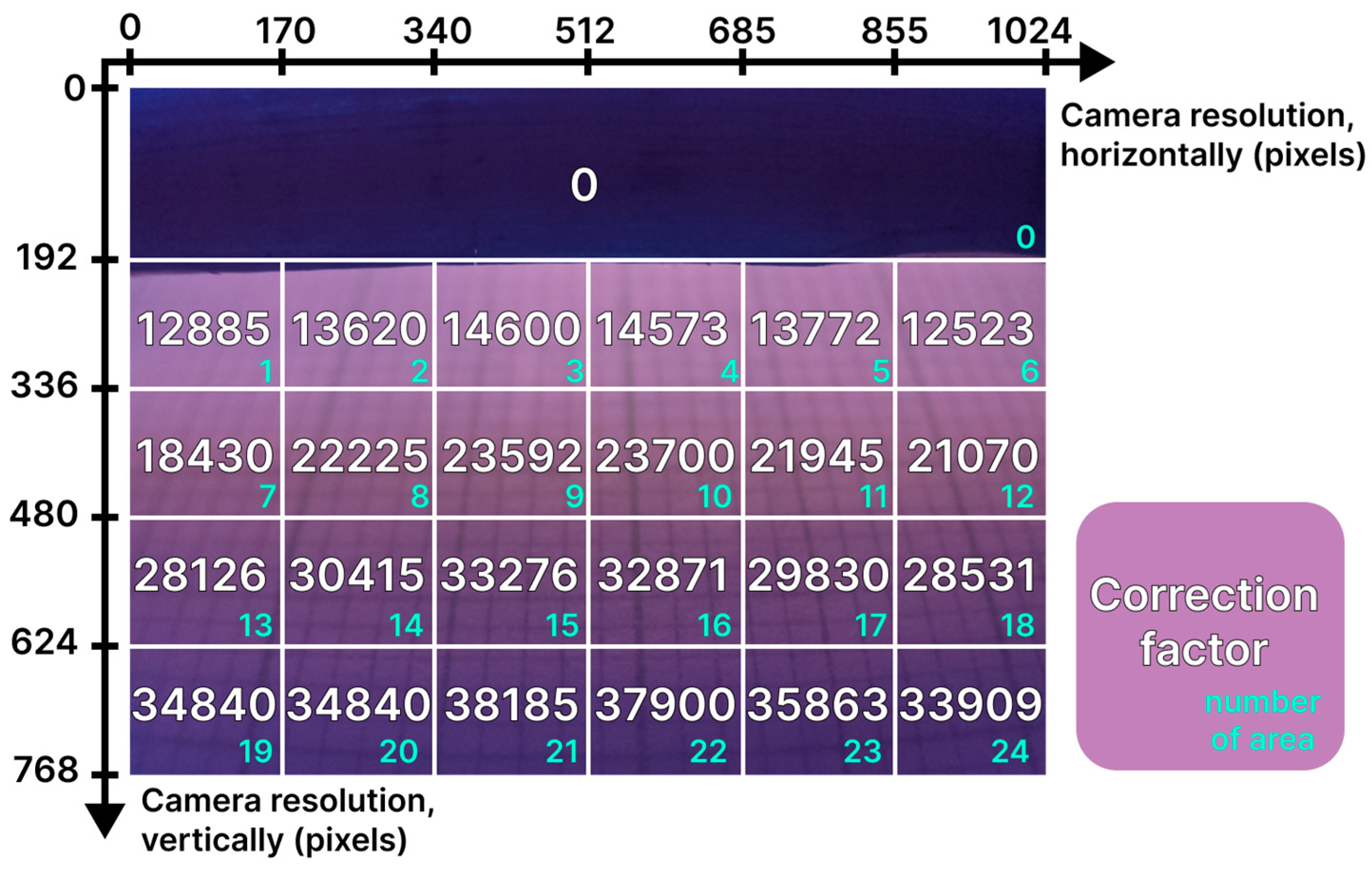

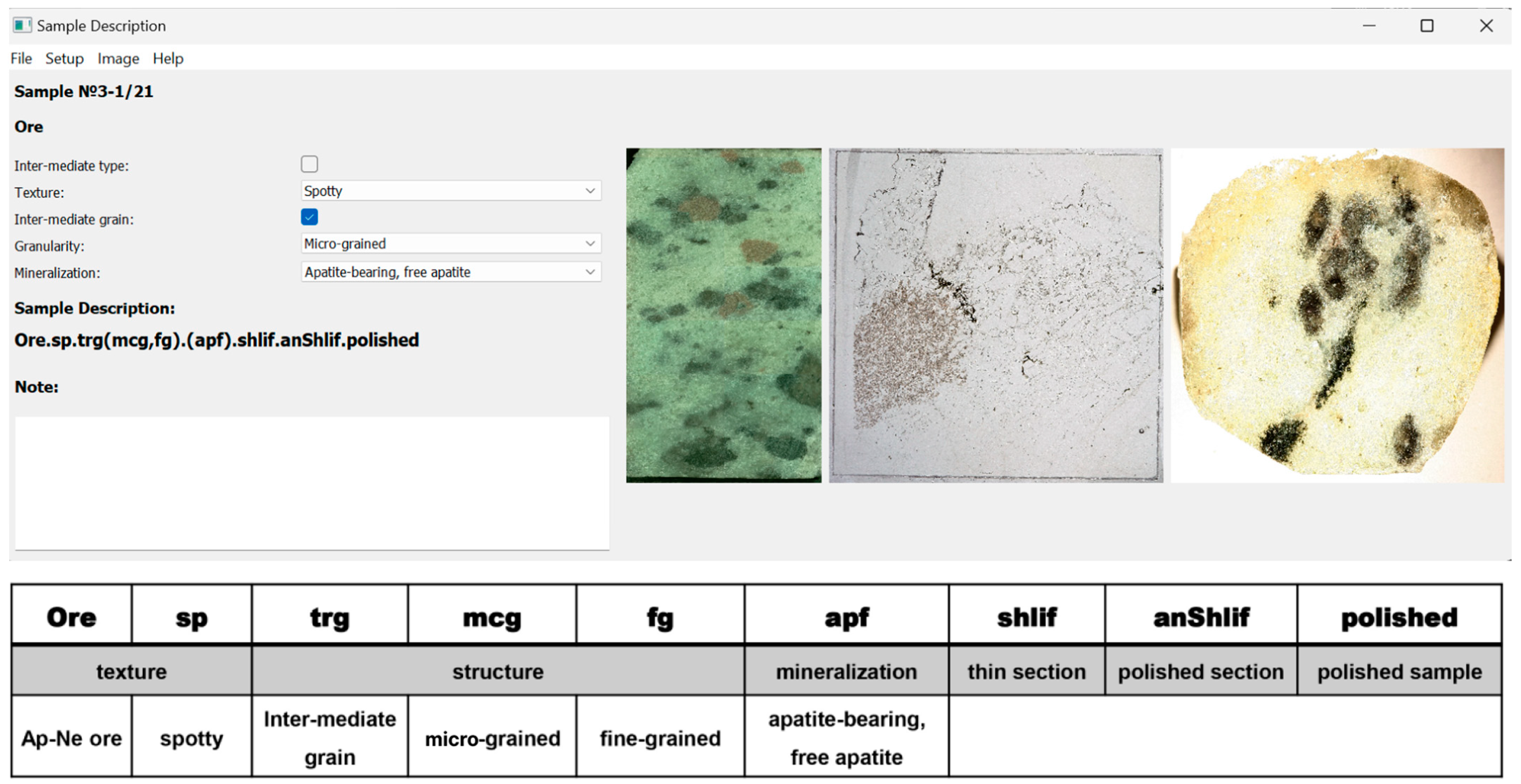

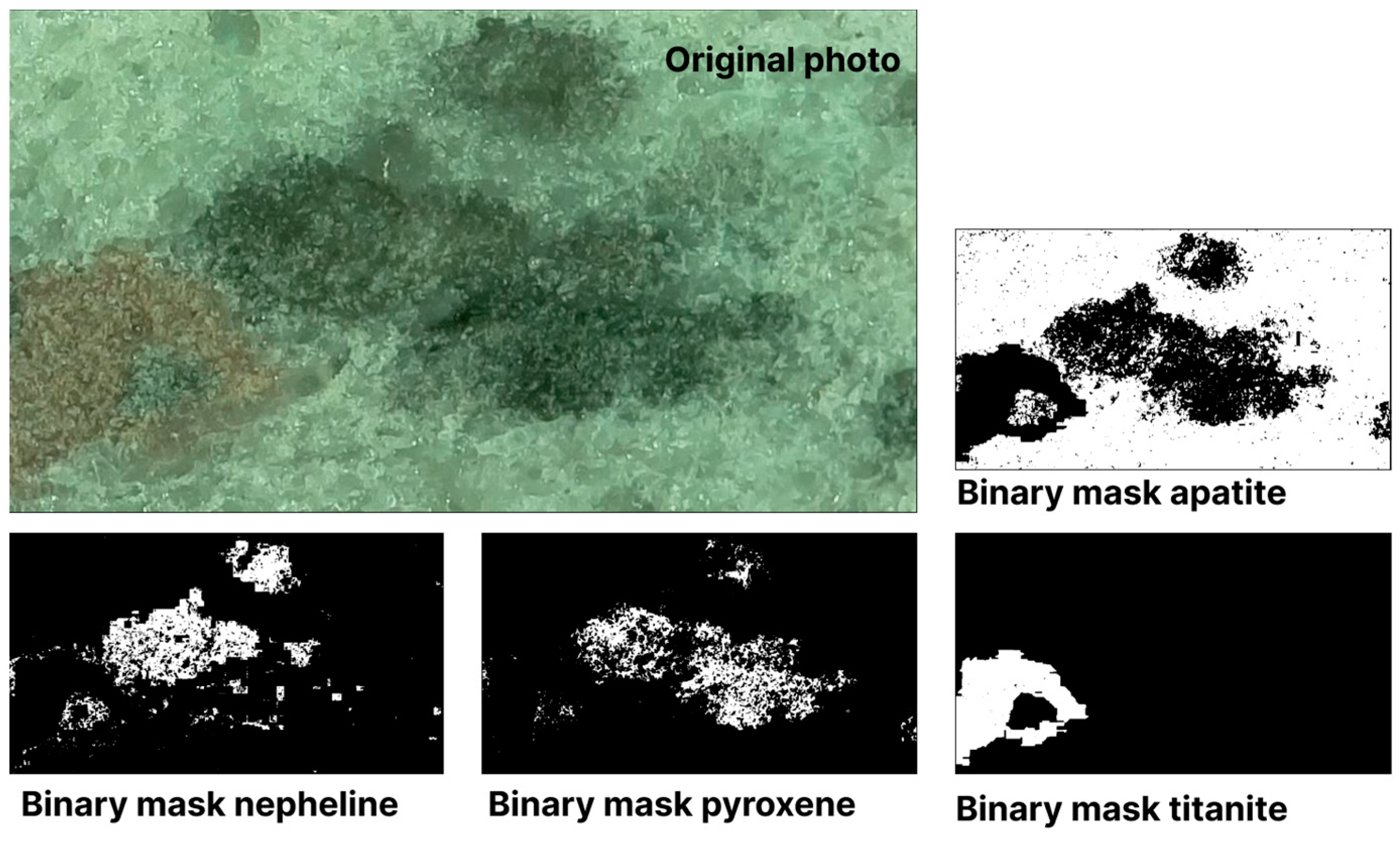

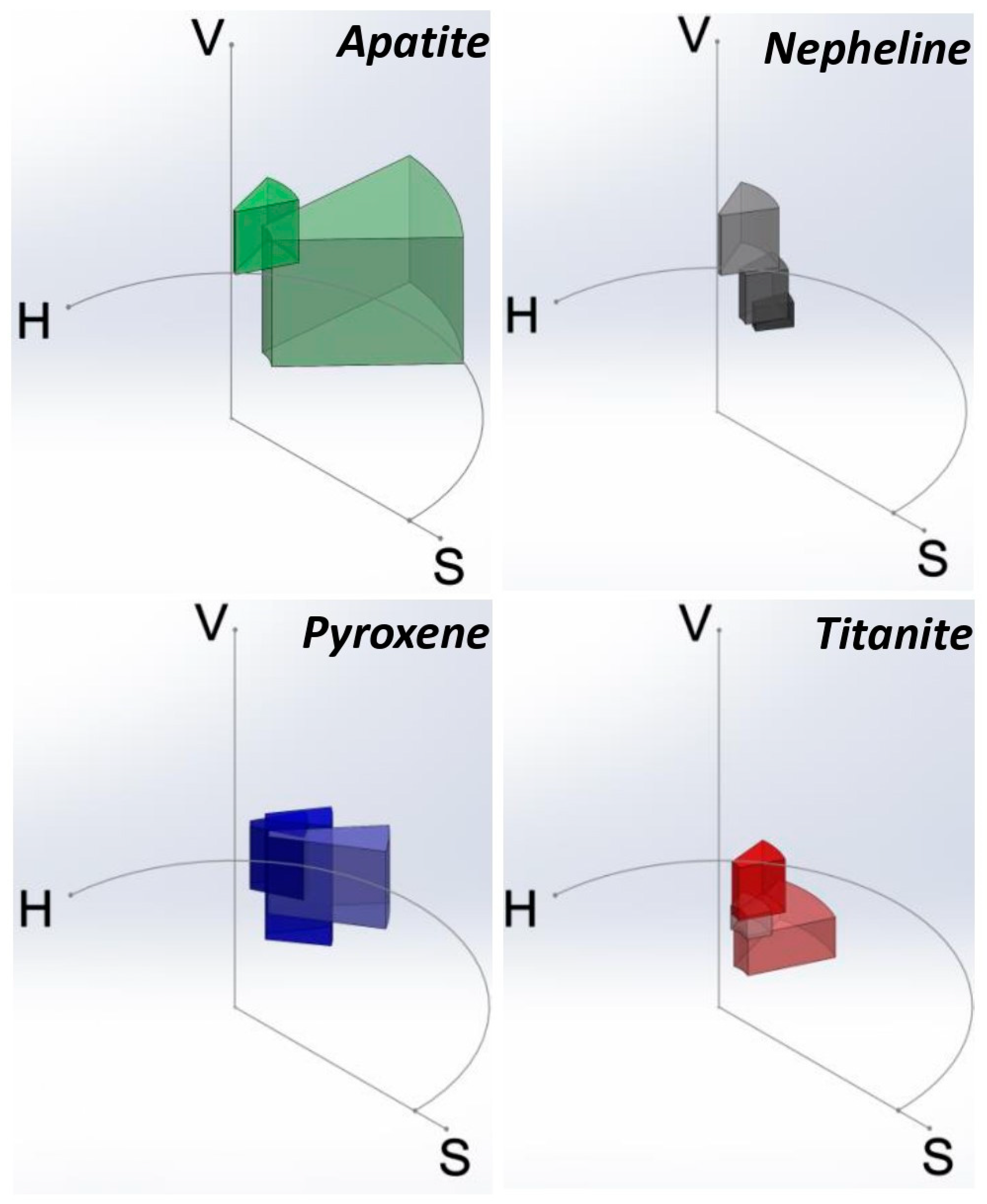
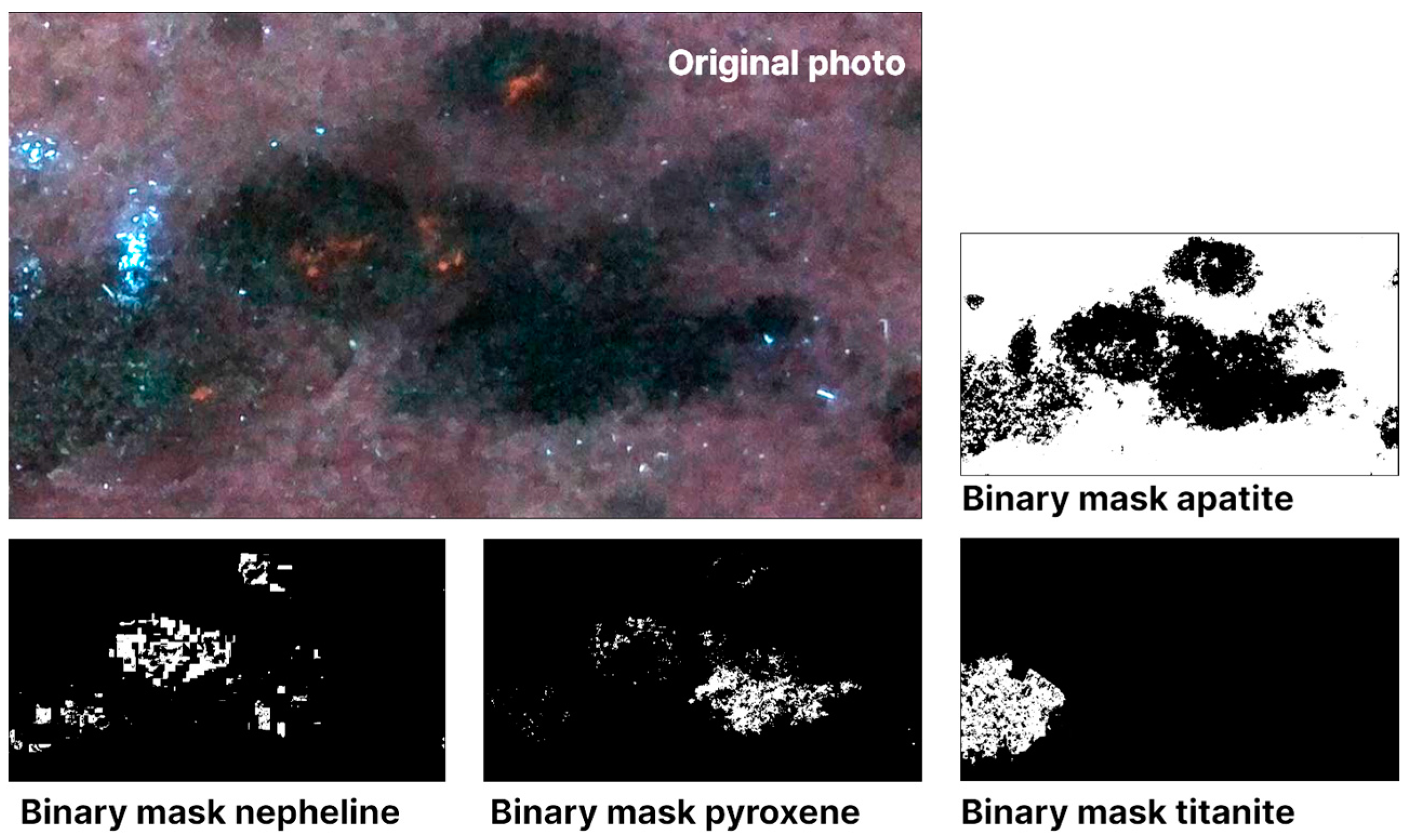
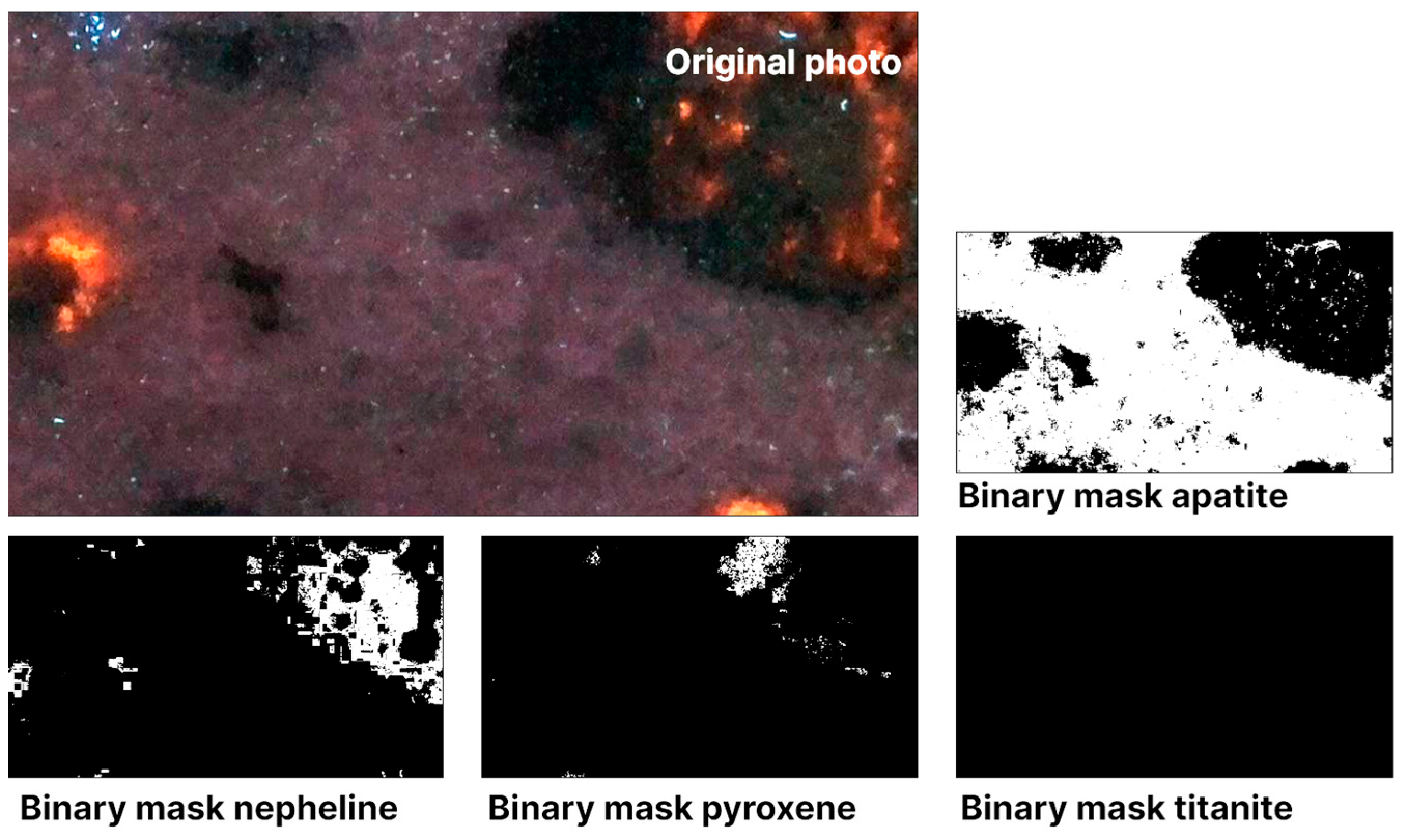

| Studied Sample | HMCA | HSV-Color Value (H,S,V) Min | HSV-Color Value (H,S,V) Max |
|---|---|---|---|
| 3-1/21 | Apatite | 42,5,177 | 74,72,255 |
| Spotty | Nepheline | 42,30,104 | 61,75,165 |
| ANO | Pyroxene | 44,29,77 | 78,56,106 |
| Titanite | 25,31,87 | 39,98,234 | |
| 1/21 | Apatite | 33,41,63 | 60,235,220 |
| Lens-shaped | Nepheline | 40,40,95 | 50,80,125 |
| Banded | Pyroxene | 46,31,31 | 75,125,80 |
| ANO | Titanite | 23,34,120 | 35,155,215 |
| 4-2/21 | Apatite | 41,4,170 | 80,65,245 |
| Agpaite | Pyroxene | 44,21,102 | 68,70,167 |
| Urtite–ijolete | Titanite | 18,16,149 | 43,73,226 |
| Studied Sample | HMCA | HSV-Color Value (H,S,V) Min | HSV-Color Value (H,S,V) Max |
|---|---|---|---|
| 3-1/21 | Apatite | 124,175,160 | 160,255,255 |
| Spotty | Nepheline | 131,215,120 | 155,255,150 |
| ANO | Pyroxene | 132,240,110 | 137,255,147 |
| Titanite | 134,240,162 | 140,255,162 | |
| 1/21 | Apatite | 118,184,55 | 133,255,195 |
| Lens-shaped | Nepheline | 133,255,136 | 139,255,160 |
| Banded | Pyroxene | 131,254,80 | 132,255,124 |
| ANO | Titanite | 140,253,150 | 140,255,194 |
| 4-2/21 | Apatite | 125,215,168 | 160,255,255 |
| Agpaite | Pyroxene | 120,230,70 | 145,255,168 |
| Urtite–ijolete | Titanite |
Disclaimer/Publisher’s Note: The statements, opinions and data contained in all publications are solely those of the individual author(s) and contributor(s) and not of MDPI and/or the editor(s). MDPI and/or the editor(s) disclaim responsibility for any injury to people or property resulting from any ideas, methods, instructions or products referred to in the content. |
© 2024 by the authors. Licensee MDPI, Basel, Switzerland. This article is an open access article distributed under the terms and conditions of the Creative Commons Attribution (CC BY) license (https://creativecommons.org/licenses/by/4.0/).
Share and Cite
Shibaeva, D.N.; Voronin, R.P.; Kompanchenko, A.A.; Volkov, D.O.; Asanovich, D.A.; Bulatov, V.V. Hardware and Software Solutions for the Generation of a Database of HSV-Color Characteristics for the Main Ores and Rocks of the Khibiny Massif. Minerals 2024, 14, 186. https://doi.org/10.3390/min14020186
Shibaeva DN, Voronin RP, Kompanchenko AA, Volkov DO, Asanovich DA, Bulatov VV. Hardware and Software Solutions for the Generation of a Database of HSV-Color Characteristics for the Main Ores and Rocks of the Khibiny Massif. Minerals. 2024; 14(2):186. https://doi.org/10.3390/min14020186
Chicago/Turabian StyleShibaeva, Darya Nikolaevna, Roman Pavlovich Voronin, Alena Arkadievna Kompanchenko, Denis Olegovich Volkov, Danil Alekseevich Asanovich, and Victor Vladimirovich Bulatov. 2024. "Hardware and Software Solutions for the Generation of a Database of HSV-Color Characteristics for the Main Ores and Rocks of the Khibiny Massif" Minerals 14, no. 2: 186. https://doi.org/10.3390/min14020186
APA StyleShibaeva, D. N., Voronin, R. P., Kompanchenko, A. A., Volkov, D. O., Asanovich, D. A., & Bulatov, V. V. (2024). Hardware and Software Solutions for the Generation of a Database of HSV-Color Characteristics for the Main Ores and Rocks of the Khibiny Massif. Minerals, 14(2), 186. https://doi.org/10.3390/min14020186







